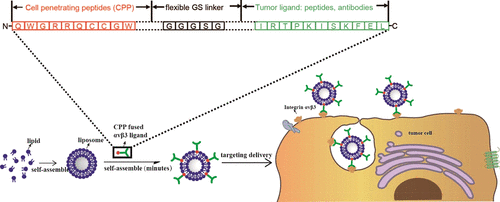当前位置:
X-MOL 学术
›
Bioconjugate Chem.
›
论文详情
Our official English website, www.x-mol.net, welcomes your
feedback! (Note: you will need to create a separate account there.)
Using a Membrane-Penetrating-Peptide to Anchor Ligands in the Liposome Membrane Facilitates Targeted Drug Delivery.
Bioconjugate Chemistry ( IF 4.0 ) Pub Date : 2019-12-27 , DOI: 10.1021/acs.bioconjchem.9b00798 Xiaobo Fan 1 , Hongbo Xu 1 , Junlong Song 2 , Yongcan Jin 2 , Michael Wink 3 , Guoqiu Wu 4
Bioconjugate Chemistry ( IF 4.0 ) Pub Date : 2019-12-27 , DOI: 10.1021/acs.bioconjchem.9b00798 Xiaobo Fan 1 , Hongbo Xu 1 , Junlong Song 2 , Yongcan Jin 2 , Michael Wink 3 , Guoqiu Wu 4
Affiliation

|
Antimicrobial peptides (AMPs) are typical cell penetrating peptides (CPPs) that intercalate into biomembranes and exhibit broad activities. We designed a triple fusion protein consisting of an AMP, Ib-AMP4 at the N-terminus, a fluorescent GFP probe in the center, and the tumor-targeting peptide P1c at the other terminus. After purification from E. coli, the interaction between the Ib-AMP4-GFP-P1c fusion protein (IGP) and the lipid membrane was characterized. Experiments using isothermal titration calorimetry (ITC) and quartz crystal microbalance with dissipation (QCM-D) demonstrated that IGP proteins spontaneously bound the lipid bilayer with a maximal molar ratio of 1:52 (protein:lipid). Furthermore, transmission electron microscopy (TEM) confirmed that the IGP protein was present in the liposome membrane. After decoration with IGP proteins, the DOPC:DOPG liposomes were applied to cancer cells. Microscopy and flow cytometry reveal that the decorated liposomes selectively bound integrin αvβ3-positive A549 cells. In addition, compared with the common chemical conjugation method, the reported method seemed to be superior in certain aspects, such as simple sample preparation and cost-effectiveness. Next, the IGP protein was applied to decorate red blood cell (RBC) liposomes for targeted delivery in both in vitro and in vivo applications. The IGP-decorated RBC liposomes preferentially targeted integrin αvβ3 expressing A549 cancer cells. The in vivo imaging showed that IGP-decorated RBC liposomes were concentrated in tumor tissue and were primarily metabolized by the liver and kidney.
中文翻译:

使用膜穿透肽锚定脂质体膜中的配体有助于靶向药物递送。
抗菌肽(AMP)是典型的细胞穿透肽(CPP),可插入生物膜并具有广泛的活性。我们设计了一个三重融合蛋白,该蛋白由AMP,N端的Ib-AMP4,中心的荧光GFP探针和另一端的肿瘤靶向肽P1c组成。从大肠杆菌中纯化后,表征了Ib-AMP4-GFP-P1c融合蛋白(IGP)与脂质膜之间的相互作用。使用等温滴定热法(ITC)和带耗散的石英晶体微量天平(QCM-D)进行的实验表明,IGP蛋白自发结合脂质双层,最大摩尔比为1:52(蛋白质:脂质)。此外,透射电子显微镜(TEM)证实了IGP蛋白存在于脂质体膜中。用IGP蛋白修饰后,将DOPC:DOPG脂质体应用于癌细胞。显微镜和流式细胞仪显示,修饰的脂质体选择性结合整联蛋白αvβ3阳性的A549细胞。另外,与普通的化学结合方法相比,所报道的方法在某些方面似乎更优越,例如简单的样品制备和成本效益。接下来,将IGP蛋白用于修饰红细胞(RBC)脂质体,以在体外和体内应用中靶向递送。具有IGP装饰的RBC脂质体优先靶向表达整联蛋白αvβ3的A549癌细胞。体内成像显示,装饰有IGP的RBC脂质体集中在肿瘤组织中,并主要通过肝脏和肾脏代谢。显微镜和流式细胞仪显示,修饰的脂质体选择性结合整联蛋白αvβ3阳性的A549细胞。另外,与普通的化学结合方法相比,所报道的方法在某些方面似乎更优越,例如简单的样品制备和成本效益。接下来,将IGP蛋白用于修饰红细胞(RBC)脂质体,以在体外和体内应用中靶向递送。具有IGP装饰的RBC脂质体优先靶向表达整联蛋白αvβ3的A549癌细胞。体内成像显示,装饰有IGP的RBC脂质体集中在肿瘤组织中,并主要通过肝脏和肾脏代谢。显微镜和流式细胞仪显示,修饰的脂质体选择性结合整联蛋白αvβ3阳性的A549细胞。另外,与普通的化学结合方法相比,所报道的方法在某些方面似乎更优越,例如简单的样品制备和成本效益。接下来,将IGP蛋白应用于修饰红细胞(RBC)脂质体,以在体外和体内应用中靶向递送。具有IGP装饰的RBC脂质体优先靶向表达整联蛋白αvβ3的A549癌细胞。体内成像显示,装饰有IGP的RBC脂质体集中在肿瘤组织中,并主要通过肝脏和肾脏代谢。所报道的方法在某些方面似乎是优越的,例如简单的样品制备和成本效益。接下来,将IGP蛋白应用于修饰红细胞(RBC)脂质体,以在体外和体内应用中靶向递送。具有IGP装饰的RBC脂质体优先靶向表达整联蛋白αvβ3的A549癌细胞。体内成像显示,装饰有IGP的RBC脂质体集中在肿瘤组织中,并主要通过肝脏和肾脏代谢。所报道的方法在某些方面似乎是优越的,例如简单的样品制备和成本效益。接下来,将IGP蛋白应用于修饰红细胞(RBC)脂质体,以在体外和体内应用中靶向递送。具有IGP装饰的RBC脂质体优先靶向表达整联蛋白αvβ3的A549癌细胞。体内成像显示,装饰有IGP的RBC脂质体集中在肿瘤组织中,并主要通过肝脏和肾脏代谢。
更新日期:2019-12-29
中文翻译:

使用膜穿透肽锚定脂质体膜中的配体有助于靶向药物递送。
抗菌肽(AMP)是典型的细胞穿透肽(CPP),可插入生物膜并具有广泛的活性。我们设计了一个三重融合蛋白,该蛋白由AMP,N端的Ib-AMP4,中心的荧光GFP探针和另一端的肿瘤靶向肽P1c组成。从大肠杆菌中纯化后,表征了Ib-AMP4-GFP-P1c融合蛋白(IGP)与脂质膜之间的相互作用。使用等温滴定热法(ITC)和带耗散的石英晶体微量天平(QCM-D)进行的实验表明,IGP蛋白自发结合脂质双层,最大摩尔比为1:52(蛋白质:脂质)。此外,透射电子显微镜(TEM)证实了IGP蛋白存在于脂质体膜中。用IGP蛋白修饰后,将DOPC:DOPG脂质体应用于癌细胞。显微镜和流式细胞仪显示,修饰的脂质体选择性结合整联蛋白αvβ3阳性的A549细胞。另外,与普通的化学结合方法相比,所报道的方法在某些方面似乎更优越,例如简单的样品制备和成本效益。接下来,将IGP蛋白用于修饰红细胞(RBC)脂质体,以在体外和体内应用中靶向递送。具有IGP装饰的RBC脂质体优先靶向表达整联蛋白αvβ3的A549癌细胞。体内成像显示,装饰有IGP的RBC脂质体集中在肿瘤组织中,并主要通过肝脏和肾脏代谢。显微镜和流式细胞仪显示,修饰的脂质体选择性结合整联蛋白αvβ3阳性的A549细胞。另外,与普通的化学结合方法相比,所报道的方法在某些方面似乎更优越,例如简单的样品制备和成本效益。接下来,将IGP蛋白用于修饰红细胞(RBC)脂质体,以在体外和体内应用中靶向递送。具有IGP装饰的RBC脂质体优先靶向表达整联蛋白αvβ3的A549癌细胞。体内成像显示,装饰有IGP的RBC脂质体集中在肿瘤组织中,并主要通过肝脏和肾脏代谢。显微镜和流式细胞仪显示,修饰的脂质体选择性结合整联蛋白αvβ3阳性的A549细胞。另外,与普通的化学结合方法相比,所报道的方法在某些方面似乎更优越,例如简单的样品制备和成本效益。接下来,将IGP蛋白应用于修饰红细胞(RBC)脂质体,以在体外和体内应用中靶向递送。具有IGP装饰的RBC脂质体优先靶向表达整联蛋白αvβ3的A549癌细胞。体内成像显示,装饰有IGP的RBC脂质体集中在肿瘤组织中,并主要通过肝脏和肾脏代谢。所报道的方法在某些方面似乎是优越的,例如简单的样品制备和成本效益。接下来,将IGP蛋白应用于修饰红细胞(RBC)脂质体,以在体外和体内应用中靶向递送。具有IGP装饰的RBC脂质体优先靶向表达整联蛋白αvβ3的A549癌细胞。体内成像显示,装饰有IGP的RBC脂质体集中在肿瘤组织中,并主要通过肝脏和肾脏代谢。所报道的方法在某些方面似乎是优越的,例如简单的样品制备和成本效益。接下来,将IGP蛋白应用于修饰红细胞(RBC)脂质体,以在体外和体内应用中靶向递送。具有IGP装饰的RBC脂质体优先靶向表达整联蛋白αvβ3的A549癌细胞。体内成像显示,装饰有IGP的RBC脂质体集中在肿瘤组织中,并主要通过肝脏和肾脏代谢。











































 京公网安备 11010802027423号
京公网安备 11010802027423号